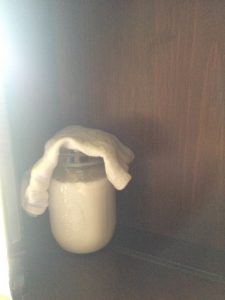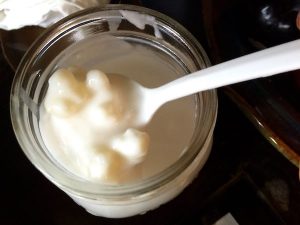
“It’s soooo easy,” my co-worker smiled, telling me about making her own kefir. She couldn’t understand why anyone would make yogurt, which you have to actually cook and keep track of. “I just transfer the kefir into a new glass of milk every day or two. And that’s it!”
Kefir is a fermented milk drink made from “grains” which are a bacterial/yeast culture. It is similar to yogurt in texture, but has a stronger flavor. As far as probiotic health, the beneficial bacteria content of kefir is about five times that of yogurt. Microorganisms present in the grains include lactic acid bacteria, Lactococcus lactis subsp. lactis, Streptococcus thermophilus, Lb delbrueckii subsp. bulgaricus, Lb helveticus, Lb casei subsp. pseudoplantarum and Lb brevis, a variety of yeasts, such as Kluyveromyces, Torulopsis, and Saccharomyces, acetic acid bacteria and more! All these keep away the “bad” bacteria that can spoil milk. Also, since the lactose is broken down during the fermentation process, most lactose-intolerant people can enjoy kefir. It is a yummy drink, but also can be used in baking as a substitute for buttermilk or regular milk in any recipe for an added flavor kick.
Interested in gut health and probiotics, I happily accepted the gift from my co-worker who gently handed me a cup of milk with kefir grains. She gave me the basic instructions and ask me to keep her updated on her “babies.” Not a regular milk drinker, I had to buy some milk to take home that day to get ready for my first transfer. Would I know what the grains looked like? Would they die in my house? My husband takes care of our plants, and does most of our garden too. But I wanted to try. It was soooo easy.

I put the little glass jar in a dark spot in my kitchen with a cloth napkin over it. The next day, I spooned out the obvious kefir cultures into a new jar and poured some milk in. The following night I dreamed of my kefir. Not kidding. They were bubbly, happy little guys swimming in the local, organic, full-fat milk I bought them, settling into their new environment. I felt like I had gotten a new pet. As I researched kefir, I found that every batch is slightly different because our localized environments (the air in my house) is going to be just slightly different than my co-workers, so the bacterial content will have a unique taste. When I strained out the grains the following day, and drank my first batch- YUM! It wasn’t like the store-bought kind I had before. It was just better.

For kids in the kitchen, keeping track of kefir can be the official job of even the youngest of your household. The hardest part is getting the kefir grains in the first place. If you don’t have a local person to give you some, here is a website where you can purchase a starter kit. Then use your food to teach science. What are micro-organisms? Why are some bacteria good for us and some bad? What chemical changes happen during the fermentation process? Wikipedia has a good start to these questions. If you want to get more, try this article. Then drink your experiment!


